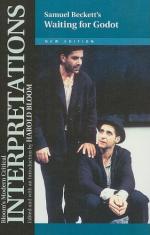|
This section contains 5,389 words (approx. 18 pages at 300 words per page) |

|
SOURCE: Lawley, Paul. “That Time and the Dynamics of Being.” Journal of Beckett Studies 10, nos. 1-2 (fall 2000/spring 2001): 173-86.
In the following essay, Lawley concentrates on the roles that voice, silence, movement, and stillness play in illuminating defensive mechanisms of human existence in That Time.
“Esse est percipi. […] No truth value attaches to the above, regarded as of merely structural and dramatic convenience.”1 Despite the severe authorial qualification appended to the Berkeleian proposition upon which Beckett bases Film (written in 1963, produced in 1964), the relevance of the dictum to Beckett's drama is manifest, if not necessarily simple.2 Indeed, the author's insistence seems disingenuous, for in connection with these plays the phrase is, as a point of reference, so convenient that (as Murphy might have said) convenience is not the word. “Esse est percipi […] might stand as the epigraph for his complete dramatic works,”3 wrote J. C. C. Mays. For...
|
This section contains 5,389 words (approx. 18 pages at 300 words per page) |

|


